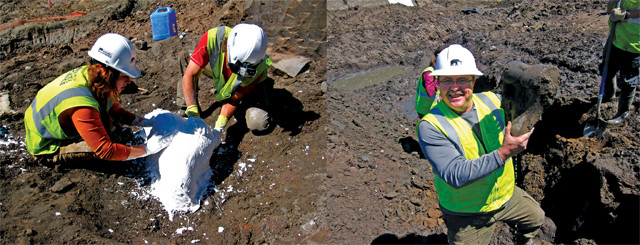
by Mary Caperton Morton Wednesday, December 9, 2015

Volunteers were involved with everything from bladerunning to digging to plastering the fossils. Below, Stephen Wagner, a volunteer team leader, holds a mastodon humerus. Credit: both: Stephen Wagner.
The Snowmastodon Project team pulled thousands of fossils out of snowy mud in a matter of months, a herculean task that would not have been as successful without a small army of volunteers, many of whom came from the Denver Museum of Nature & Science’s paleontology program. The program trains interested laypeople in the art of collecting, studying and curating fossils, one of the only programs like it in the world.
“This is really a unique program,” says Stephen Wagner, a retired software engineer based in Denver who has volunteered with the Earth Sciences division of the Denver museum since 2002. “The number of hours the volunteers donate to the museum is pretty incredible.”
When Wagner heard about the dig at Snowmass Village, he signed up to lead a team of six volunteers for a two-week stint at the site, despite freezing temperatures and several feet of snow in the forecast. “It was an arduous dig, to say the least, but the rewards were worth it. In one day I found 67 bones. With each shovelful of dirt, you could find something amazing,” he says.
Most of the two dozen volunteers on the dig were long-time volunteers at the museum, with multiple digs under their belts. Still, “there was a lot to learn about how this particular project needed to be done, especially how to record the location of the bones as they came out of the ground,” Wagner says.
The museum staff installed reference stakes in the lake bed using GPS coordinates, and each time a bone was found, the volunteers would measure the precise distance and orientation from the stake. “There were a lot of bones and we had to record a lot of data,” he says.
Ian Miller and museum staff formally thanked the volunteers in the series of papers written about the Snowmastodon fossils, but Wagner emphasizes the appreciation goes both ways. “The museum has spent a lot of time and effort educating us and providing us the opportunity to go on these digs. So I want to say thanks to them for letting us live out our paleo-dreams.”
© 2008-2021. All rights reserved. Any copying, redistribution or retransmission of any of the contents of this service without the expressed written permission of the American Geosciences Institute is expressly prohibited. Click here for all copyright requests.